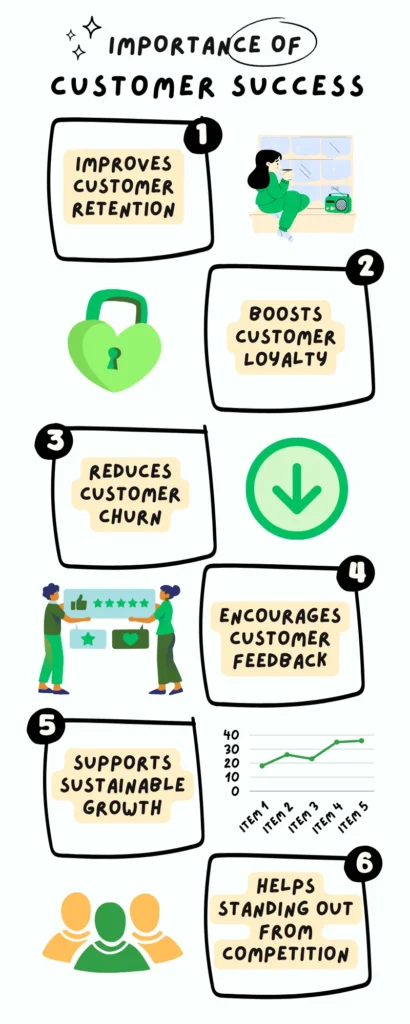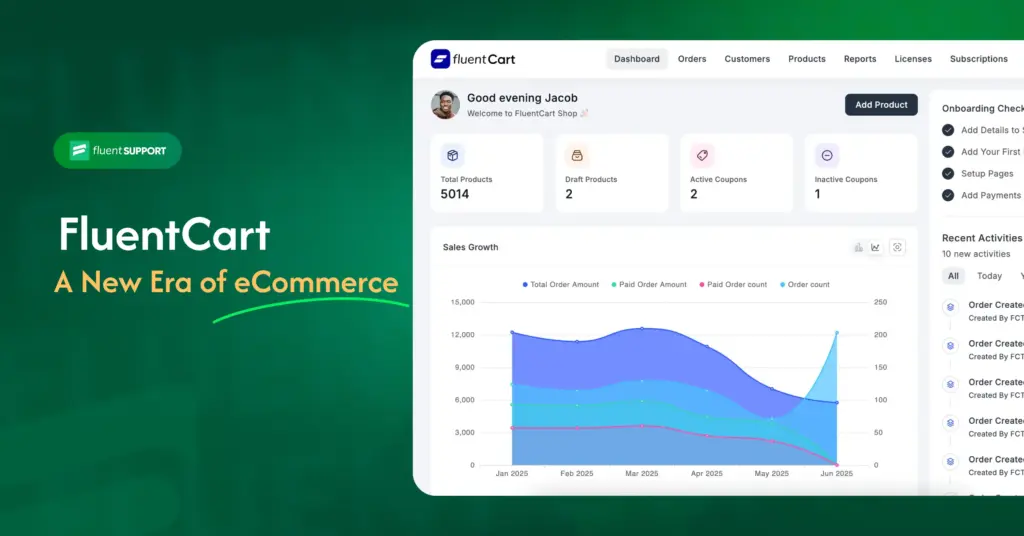
10 Customer Success Best Practices to Follow in 2025
The secret to business success is happy customers. More companies are learning that helping customers succeed is key to earning their loyalty. This focus on customer success isn’t just good manners. Also, it is good business, proven by some powerful statistics.
For example, research by Forrester shows that “a well-designed customer success program can yield a 91% ROI over three years”. Moreover, Bain & Company found that “improving customer retention by just 5% boosts profits by 25% to 95%.” These numbers show that if you can apply customer success best practices, it can significantly impact a company’s bottom line.
Besides, happy customers can quickly become vocal advocates for a brand. A report by Adobe found that “businesses focusing on customer experience were three times more likely to significantly exceed their goals for the year.” This connection between customer satisfaction and business success is clear and strong.
So, without further ado, let’s discuss customer success in detail and some of its best practices.
What is customer success?
Customer success is about ensuring your customers are happy and achieve what they want with your product or service. It involves helping them use your product effectively and providing a good experience.
Importance of customer success
Customer success is not just about helping customers when they encounter problems. It’s about ensuring they achieve ongoing value from products or services. This proactive approach is crucial for several reasons:

1. Improves customer retention
Improving customer retention is crucial because it’s more cost-effective than finding new ones. Customer success helps by ensuring customers are happy and getting what they need from the product or service. This prevents them from leaving for a competitor.
2. Boosts customer loyalty
When customers like what a company offers, they stay and tell others. Happy customers become loyal to the brand and bring in more customers.
3. Reduces customer churn
Customer success identifies unhappy customers early and offers solutions to improve their experience. This can prevent them from leaving (churning) and open up opportunities to sell additional services (upselling).
4. Encourages feedback
Regularly talking to customers helps companies get valuable feedback. This information can guide product improvements and innovations. Acting on customer feedback also shows customers they are valued.
5. Supports sustainable growth
Focusing on customer success means making happy customers. Happy customers will likely renew their contracts and buy more products or services. This approach leads to stable and sustainable growth.
6. Help standing out from competition
In a market where many products are similar, offering excellent customer success can set a company apart. It proves the company values its customers’ ongoing success, not just making sales. This care influences customers’ choices.
The 10 customer success best practices
Businesses need to adopt specific best practices to implement customer success effectively and truly benefit from it. Here are 10 best practices for customer success and how these can be applied:
1. Understand customer goals to improve support
Before you can support your customers, you have to understand what goals they are thinking of. Knowing the purpose makes it easier for you to give them assistance targeted to their goals.
So, don’t forget to ask them why you buy your product or service and listen to their answers. When you know what your customers are up to, you can lead them more efficiently.
2. Set goals for each step of the customer journey
Think of your customer’s experience with your product as a journey with different stages. Set specific goals for each stage of customer journey. For example, when a customer first buys your product, your goal might be to help them learn how to use it.
As they get more comfortable, your goals might shift towards helping them make the most out of it. This approach helps you keep track of their progress and ensures they are satisfied every step of the way.
3. Reach out first to meet customer needs
Customers will not approach you with trouble, so you must meet them where they are. Attempt to talk to them rather than sending them the first letter yourself. Such a strategy directly reacts to customers’ emotions and, thus, reduces their dissatisfaction and frustration.
See how they are coping with their work, if they have any questions or doubts, or if they require anything more. Not only does this improve their experience, but the small problems also become bigger issues with time.
Proactive support and regular communication are the pillars of customer success. Engage with your customers before issues arise to build lasting loyalty.
– Oleh Maksymovych, General Manager at Cloudfresh.
4. Offer personalized support
Each customer is unique, so their support should be too. Personalized support can include using the customer’s name, remembering their preferences, and recalling past interactions.
This makes the support experience feel more tailored and can significantly enhance customer satisfaction. Customers who feel that the support is designed just for them are likelier to be happy with your service.
5. Use feedback to improve products and services
Customer feedback is the most precious resource; therefore, listen carefully to your clients to see how they react to your offer. Feedback can come from surveys, interacting directly with customers on the phone, online reviews, or social media.
Use this to your benefit and make the necessary amendments. For instance, if several clients offer a feature that would improve the product, the given feature should certainly be added.
Periodic updates of your products under customer reviews will ensure that they align with their needs and expectations.
6. Use technology to boost customer success
Tech can greatly improve the way you offer customer services to your clients. Engage with the help of a CRM system, keeping your customer interactions, choices, and history in one place.
Automation will assist in personalized emails. These may include regular updates, special offers, or emails based on customers’ tastes. With the help of this chatbot and virtual agents, companies can now implement 24/7 support to answer common questions and solve basic issues to improve the overall customer experience.
7. Keep an eye on customer health to solve problems early
“Customer health” refers to how happy your customers are with your product and how likely they are to keep using it. You can catch and address problems before they grow by monitoring customer health.
Use indicators like product usage frequency, support ticket frequency, and direct customer feedback to gauge their satisfaction. If you notice a customer’s interaction declining or an increase in complaints, contact them to solve any issues.
This proactive approach helps retain your customers and maintain a positive brand image.
8. Give customer success teams power and resources
Empower your customer success teams by giving them the necessary tools and authority to make decisions. Such software can help track interaction with the customer, generate analytics that provide insights into the customer’s behavior, and resolve many issues without urgent approval.
9. Build lasting relationships
Develop bonds with the clients rather than trying to sell them something. Get familiar with your customers’ paths and needs, and provide feedback. Regular communication is vital here. You can update them through emails, newsletters, and phone calls to convince them they are highly valued.
Through the firm establishment of these mutually beneficial relationships, it is much more likely that customers will be loyal to your brand and always turn to your product or service in the long term.
10. Celebrate Both Small and Big Wins to Show Their Value
The power of positive feedback cannot be underestimated. Recognize and celebrate the smallest customers’ achievements regarding using your product.
In the broadest sense, they may have accomplished a big achievement or small others, in which case applauding their success affords them a sense of value.
This can be achieved via shout-outs on various social media platforms, mentioning them in your emails, or even by sending personalized thank you or prize-giving messages. This encourages customers to strive for success.
Customer Success FAQs
Here are some frequently asked questions about customer success.
What are the 4 pillars of customer success?
- Onboarding: Properly introducing customers to the service or product. This ensures them how to use it.
- Adoption: Ensuring customers fully integrate and utilize the product or service in their daily operations or routines.
- Value realization: Helping customers achieve their goals through the product, demonstrating its tangible benefits.
- Retention: Maintaining ongoing support and engagement to ensure continued satisfaction and prevent churn.
What is a customer success model?
A customer success model helps customers achieve their goals with a product or service. It includes strategies for onboarding, ongoing support, and proactive engagement.
How do you achieve customer success?
Achieving customer success involves:
- Understanding customer needs: Understanding what customers need to achieve with the product or service.
- Proactive support: Offering help before customers become frustrated, including educational resources and customer training.
- Regular communication: Keeping in touch with customers through updates, check-ins, and feedback sessions. This ensures that they feel valued and listened to.
- Personalization: Tailoring interactions and solutions to each customer’s specific needs.
- Feedback utilization: Regularly collecting and acting on customer feedback. This improves the product and customer experience.
What are the three levels of customer satisfaction?
The three levels of customer sastisfaction are:
- Basic satisfaction: Customers’ fundamental expectations are met, but may switch to a competitor if a better option appears.
- Enhanced satisfaction: Customers receive added value beyond the basic offerings. This helps in differentiating from competitors.
- Emotional satisfaction: Customers feel a connection to the brand. This happens often due to exceptional service and positive experiences, which can finally lead to customer advocacy.
Wrapping up
Mastering customer success is essential for building lasting relationships and driving business growth. You ensure customer satisfaction, loyalty, and advocacy by implementing these 10 best practices, from personalized onboarding to proactive customer support.
Use these strategies to turn every customer interaction into an opportunity for growth and watch as they translate into tangible results for your business. Remember, successful customers make a successful business.
Start off with a powerful ticketing system that delivers smooth collaboration right out of the box.












Leave a Reply